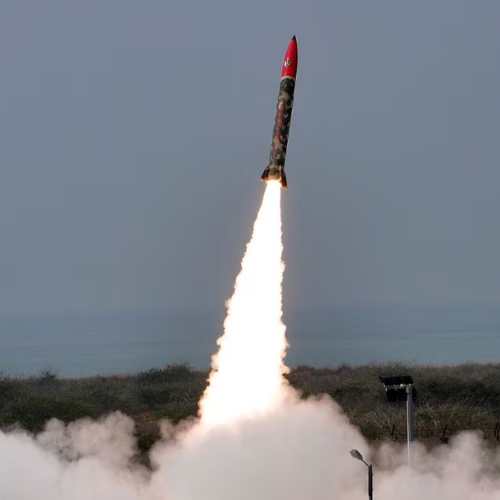Pakistan’s latest ballistic missile, the Fatah-II, was shot down by India’s air defence system just after it was launched towards the Indian capital, New Delhi. The incident marks one of the most serious escalations in the ongoing tensions between the two countries. This missile, which Pakistan considers a key symbol of its growing military strength, was destroyed mid-air, preventing any potential damage to civilian lives in one of the world’s most populous cities.
What is the Fatah-II?
The Fatah-II is a long-range ballistic missile developed by Pakistan’s military as part of its strategy to enhance its ability to strike far beyond its borders. With a range of up to 400 kilometers, the Fatah-II is a significant upgrade from its predecessor, the Fatah-I, which could only travel 140 kilometers. The new missile is part of Pakistan’s larger effort to modernize its military arsenal and boost its deterrent capabilities.
The Fatah-II is unique due to its advanced guidance system and the way it flies. Unlike many traditional missiles, it follows a flatter trajectory, making it harder for radar systems to detect and intercept it. This characteristic was one of the reasons why Pakistan touted the missile as a powerful tool for its defense, claiming that it would help strengthen the country’s military capabilities.
However, the missile’s deployment and its use in this situation have raised alarms. This missile was reportedly aimed directly at New Delhi, a heavily populated city, which could have resulted in catastrophic consequences if it had reached its target. Fortunately, India’s air defense systems quickly detected the missile after launch and neutralized it mid-air, over the town of Sirsa, in Haryana, preventing it from reaching its intended destination.
PL-15 Missile Combat Confirmed China Unleashes Powerful Weapon in Real Battle
The Escalating Tensions: Operation Bunyanun Marsoos
The missile attack was just one part of a larger military offensive launched by Pakistan under the operation named “Bunyanun Marsoos,” meaning “concrete structure.” This operation was aimed at targeting Indian military installations and key strategic areas. It began with cross-border shelling and drone attacks, followed by the Fatah-II missile strike. According to reports, Pakistani forces launched more than 300 drones in a single night, targeting a wide range of Indian locations, stretching from Jammu and Kashmir to Gujarat.
The operation, which Pakistan claims is meant to secure its military assets, led to casualties on both sides. In India, one attack in the Punjab region left a family injured, marking the first confirmed civilian casualties in this ongoing conflict. The response from India was swift and decisive. India launched a series of counterattacks, including airstrikes and drone strikes on multiple Pakistani military bases.
The missile launch and the follow-up airstrikes highlighted the rapidly escalating situation along the India-Pakistan border. The attack on New Delhi with such a powerful weapon represents a sharp shift in Pakistan’s military strategy. Historically, Pakistan has avoided direct attacks on India’s capital, but this missile strike shows a more aggressive approach.
India’s Immediate Retaliation and Ongoing Tensions
India’s response to the missile launch was quick and decisive. Indian forces used their air defense systems to intercept the Fatah-II missile, preventing it from causing any harm to New Delhi. Following the missile strike, India also launched retaliatory strikes on several key Pakistani military targets. Airbases in Rawalpindi, Shorkot, and Chakwal were targeted, with damage reported at some of the facilities. Despite Pakistan’s efforts to downplay the impact, the Indian counteroffensive underscored the seriousness of the conflict.
The situation on the ground has been tense, especially in the border regions. Pakistan’s aggressive missile launch and ongoing drone attacks have led to heightened security measures across India’s northern states. In addition, power cuts, blocked highways, and intense shelling along the border have disrupted civilian life, with many people evacuating from areas near the border for safety. Schools and government offices have been shut down in many areas within 100 kilometers of the border as a precaution.
While the missile strike was a dramatic and dangerous development, it also showed the strength and capabilities of India’s air defense systems, which managed to intercept the missile before it could cause any harm to civilians. The successful interception also highlights the ongoing arms race between India and Pakistan, with both countries investing heavily in new military technologies as they seek to maintain a strategic advantage in the region.
The Fatah-II missile, once seen as a symbol of Pakistan’s pride and military advancement, is now just a reminder of the high stakes in the ongoing military standoff between the two countries. The escalation over the past few days has raised concerns about the future of the region, with both sides remaining on high alert and the threat of further military actions lingering in the air.

